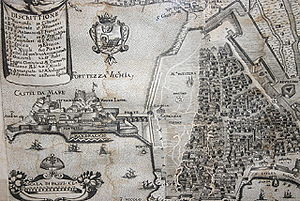Siege of Corfu (1537)
| Siege of Corfu | |||||||
|---|---|---|---|---|---|---|---|
| Part of Ottoman–Venetian War (1537–1540) | |||||||
 The French and Ottoman fleets joined at the siege of Corfu in early September 1537. | |||||||
| |||||||
| Belligerents | |||||||
|
|
| ||||||
| Commanders and leaders | |||||||
|
|
| ||||||
| Strength | |||||||
|
25,000 soldiers 320 ships | Unknown | ||||||
The siege of Corfu in 1537 was led by the Ottoman Emperor Suleiman the Magnificent, against the Republic of Venice-held island of Corfu. It is part of the Ottoman–Venetian War (1537–1540), one of the numerous Ottoman–Venetian Wars of the period.
Avlona expedition
[edit]For 1537 important combined operations had been agreed upon between France and the Ottoman Empire as part of the Franco-Ottoman alliance, in which the Ottomans would attack southern Italy and Naples under Barbarossa, and Francis I would attack northern Italy with 50,000 men. Suleiman led an army of 300,000 from Constantinople to Albania, with the objective of transporting them to Italy with the fleet.[1] The Ottoman fleet gathered in Avlona with 100 galleys, accompanied by the French ambassador Jean de La Forêt.[2] They landed in Castro, Apulia by the end of July 1537, and departed two weeks later with many prisoners.[2] Barbarossa had laid waste to the region around Otranto, carrying about 10,000 people into slavery. Francis however failed to meet his commitment, and instead attacked the Netherlands.
Siege
[edit]The Ottomans departed from Southern Italy, and instead diverted their forces to mount the Siege of Corfu, a possession of the Republic of Venice, in August 1537.[3] Suleiman decided to leave Avlona for Corfu on 19 August 1537.[4] The fleet, composed of about 320 ships,[5] started bombarding Corfu on 26 August.[4] Ottoman troops amounting to 25,000 men were landed on the island of Corfu.[4]

At the siege, the Ottomans were met by the French Admiral Baron de Saint-Blancard, who had left Marseille on 15 August with 12 galleys, and arrived at Corfu in early September 1537.[2][6] Saint-Blancard in vain attempted to convince the Ottomans to again raid the coasts of Apulia, Sicily, and the March of Ancona. Eventually Suleiman, worried by a plague among his troops,[7] decided to return with his fleet to Istanbul by mid-September without having captured Corfu.[2]
French ambassador Jean de La Forêt became seriously ill and died around that time.[2] Francis I finally penetrated into Italy, and reached Rivoli on 31 October 1537.[8]
The fleet of Saint-Blancard wintered in Chios until 17 February 1538.[9] It was decided that three ships would go to Constantinople, while the rest of the fleet returned to France. In Constantinople, they were received by the French ambassador Charles de Marillac.[10] Hayreddin Barbarossa provided for the expenses, and the French galleys finally left on 11 April 1538 to return to Nice through Monastir.[11]
A consequence of the siege was that the Venetians decided to form an alliance with the Pope and the Habsburg against the Ottomans.[12] On 18 June 1538, Francis I signed the Truce of Nice with Charles V, thereby temporarily abandoning the Franco-Ottoman alliance.[13]
Notes
[edit]- ^ History of the Ottoman Empire and modern Turkey Ezel Kural Shaw p.97ff [1]
- ^ a b c d e The Papacy and the Levant (1204-1571) by Kenneth M. Setton
- ^ Lambton, Ann Katherine Swynford; Lewis, Bernard (1977-01-01). The Cambridge History of Islam: A. The central islamic lands from pre-islamic times to the First World War. Cambridge University Press. ISBN 9780521291354.
- ^ a b c Garnier, p.135
- ^ Garnier, p.128
- ^ Garnier, p.134
- ^ Garnier, p.138
- ^ Dyer, Thomas Henry (1861-01-01). The history of modern Europe: from the fall of Constantinople, in 1453, to the war in the Crimea, in 1857. J. Murray. p. 574.
Saint Blancard Barbarossa.
- ^ Garnier, p.149
- ^ Garnier, p.150
- ^ Garnier, p.151-153
- ^ Garnier, p.140
- ^ Garnier, p.154
References
[edit]- Garnier, Edith L'Alliance Impie Editions du Felin, 2008, Paris ISBN 978-2-86645-678-8 Interview
- Sieges of the Ottoman–Venetian Wars
- Conflicts in 1537
- Sieges of Corfu (city)
- Suleiman the Magnificent
- Sieges involving the Ottoman Empire
- Sieges involving the Republic of Venice
- 1537 in the Ottoman Empire
- 1537 in Europe
- 1537 in the Republic of Venice
- Venetian rule in the Ionian Islands
- Ottoman–Venetian War (1537–1540)
